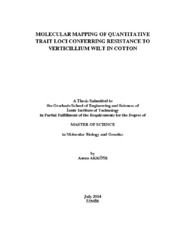Please use this identifier to cite or link to this item:
https://hdl.handle.net/11147/4196Full metadata record
| DC Field | Value | Language |
|---|---|---|
| dc.contributor.advisor | Doğanlar, Sami | |
| dc.contributor.author | Akköse, Asena | - |
| dc.date.accessioned | 2014-11-19T12:43:28Z | |
| dc.date.available | 2014-11-19T12:43:28Z | |
| dc.date.issued | 2014 | |
| dc.identifier.uri | http://hdl.handle.net/11147/4196 | |
| dc.description | Thesis (Master)--Izmir Institute of Technology, Molecular Biology and Genetics, Izmir, 2014 | en_US |
| dc.description | Includes bibliographical references (leaves: 50-53) | en_US |
| dc.description | Text in English; Abstract: Turkish and English | en_US |
| dc.description | ix, 53 leaves | en_US |
| dc.description.abstract | Cotton with its valuable natural fiber is an economically important field plant. Resistance against stress conditions and diseases are desired traits in cotton production. Verticillium wilt is one of the major factors resulting in huge cotton yield losses. Control of Verticillium disease has not been successful because of low genetic diversity and a complex disease mechanism. Moreover resistance against Verticillium wilt is a quantitative trait that is regulated by more than one gene and under environmental effects. Due to this complex inheritance, conventional breeding methods have not resulted in efficient resistance. Therefore, it is necessary to develop cotton lines resistant to Verticillium wilt using molecular breeding techniques. In this study we aimed to identify the quantitative trait loci which are responsible for Verticillium wilt resistance. For this purpose, we carried out a Verticillium wilt disease test in a natural population composed of 118 individuals. We inoculated the population with Verticillium dahliae in five replicates. After one month, the symptoms were examined and phenotypic variation was detected and scored. We then used 100 SSR markers for genotyping of the population. Population structure was determined with STRUCTURE 2.2.3. According to results, we determined two clusters. There were 44 and 34 individuals in the first and second clusters, respectively. A total of 40 individuals remained intermixed. Association analysis between phenotypic and allelic data was carried out with TASSEL 2.1. In this way we identified 30 SSR markers associated with Verticillium wilt resistance at a significance level of p<0.05. The most significant SSR locus was DPL080-238 (p=0.0014). Moreover, SSRs DPL188-130 and DPL223-251 showed the highest values for dominant and recessive allelic effects, respectively. We hope that our study will be helpful for the development of marker-assisted strategies for breeding of Verticillium wilt resistant cotton cultivars. | en_US |
| dc.language.iso | en | en_US |
| dc.publisher | Izmir Institute of Technology | en_US |
| dc.rights | info:eu-repo/semantics/openAccess | en_US |
| dc.subject.lcsh | Verticillium wilt of cotton | en_US |
| dc.subject.lcsh | Cotton--Disease and pests | en_US |
| dc.subject.lcsh | Cotton--Genetics | en_US |
| dc.title | Molecular mapping of quantitative trait loci conferring resistance to verticillium wilt in cotton | en_US |
| dc.title.alternative | Pamuk'ta verticillium solgunluğuna dayanıklılık sağlayan kantitatif karakter lokusların moleküler haritalanması | en_US |
| dc.type | Master Thesis | en_US |
| dc.authorid | TR119267 | en_US |
| dc.institutionauthor | Akköse, Asena | - |
| dc.department | Thesis (Master)--İzmir Institute of Technology, Molecular Biology and Genetics | en_US |
| dc.relation.publicationcategory | Tez | en_US |
| item.grantfulltext | open | - |
| item.openairetype | Master Thesis | - |
| item.languageiso639-1 | en | - |
| item.cerifentitytype | Publications | - |
| item.fulltext | With Fulltext | - |
| item.openairecristype | http://purl.org/coar/resource_type/c_18cf | - |
| Appears in Collections: | Master Degree / Yüksek Lisans Tezleri | |
Files in This Item:
| File | Description | Size | Format | |
|---|---|---|---|---|
| 10013429.pdf | MasterThesis | 1.85 MB | Adobe PDF |  View/Open |
CORE Recommender
Page view(s)
132
checked on Jul 15, 2024
Download(s)
74
checked on Jul 15, 2024
Google ScholarTM
Check
Items in GCRIS Repository are protected by copyright, with all rights reserved, unless otherwise indicated.